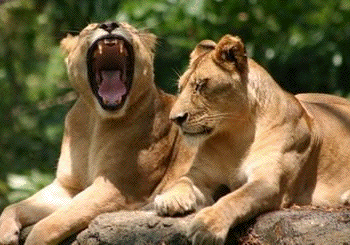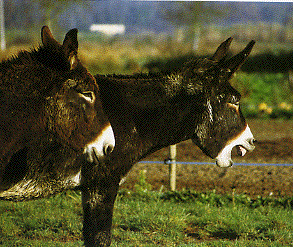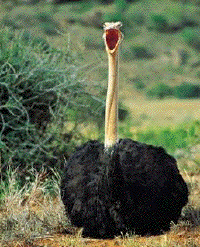- Yawning and stretching
(pandiculatio), like all forms of mammalian
(or others) behavior, occurs within definable
contexts. These contexts can range from
abstracted statements to concrete observations
of the sequential ordering of specific motor
events. Any given expressive event occurs within
the context of other such events. No aspect of
behavioral expression is an island unto
itself.
-
- The relevance of this combination of
contextual and component concerns for those
interested in mechanisms is that the events
underlying different aspects of behavioral
expression (i.e., yawning versus
something else, sleep?) are both separable and
yet linked to varying degrees to one another.
Behavioral context, as thus regarded, is an
essential supplement to the search for
mechanisms that might otherwise be restricted to
artificially isolated events. As illustration,
yawning and stretching often occur
between protracted quiet and active states
(e.g., sleep and exploration or mating). It
frequently serves as a "transitional element" in
this sense, as if the animal yawns before
it settles clearly into something else.
-
- Darwin
commented insightfully upon such behavioral
expressions, and in more recent years
ethologists have discussed them under the
general rubric of "displacement
activities". Displacement activities are
behaviour patterns (mostly body care activities)
characterized by their apparent irrelevance to
the situation in which they appear. Scratching,
autogrooming, yawning and body shaking
are among the most commonly reported
displacement activities in non-human primates,
rodents, dogs and cats.
-
- In both nonhuman primates and human
subjects, displacement behavior appears in
situations characterized by social tension and
is likely to reflect increased autonomic
arousal. Pharmacological studies of nonhuman
primates have shown that the frequency of
occurrence of displacement behavior is increased
by anxiogenic compounds. Ethological studies of
healthy persons and psychiatric patients during
interviews have found that increased
displacement behavior not only correlates with a
subjective feeling state of anxiety and negative
affect but also gives more veridical information
about the subject's emotional state than verbal
statements and facial expression. Can be
yawning a displacement activity by humans
?
-
- When animals change between behaviors, they
are not merely responding in a passive way to
conditions of the environnement, like day-night
succession, for example. Rather, they are
following internally generated signals produced
by homeostasis procedures originating from the
hypothalamus (suprachiasmatic nucleus, SCN, and
paraventricular nucleus, PVN,
of the hypothalamus). This internal rhythm
has the ability to anticipate the transitions
and triggers behavioral and physiological
changes in accordance with those transitions.
This association has two advantages :
predictability and the possibility to detect the
unexpected. Yawning is a behavior which
shares these characteristics and appears to be
associated with transitions between periods of
high and low activity or arousal. A circadian
pattern has been found in spontaneous yawning.
In normal, unstressed humans daily peaks of
yawning are associated with transitions
from sleeping to waking and from waking to
sleeping.
-
- Stretching
and yawning as
stress's symptom by animals
- Yawning:
a stress's symptom ?
-
-
 -
- Le
bâillement: une activité
substitutive ?
-
- Bâillements et étirements
(pandiculations) comme tous les
comportements des mammifères (et d'autres
animaux), surviennent dans un contexte bien
définis répondant à une
sollicitation interne ou externe mais jamais
isolément. Il existe, en
général, une association de
comportements différents (synergiques ou
antagonistes) et/ou chronologiquement
régulièrement
associés.
-
- C'est pour cela que l'examen du contexte
dans lequel apparaît un comportement est
essentiel à son appréciation. A
titre d'exemple, bâillements et
pandiculations apparaissent lors de la
transition entre le sommeil et la veille ou
l'inverse. L'animal bâille clairement
avant d'entreprendre une activité
nouvelle après avoir dormi ou, à
l'opposé, va s'endormir après
s'être dépensé.
-
- Darwin
s'est peu penché sur ce type
d'évenement comportemental mais les
éthologistes s'y sont beaucoup
intéressés depuis. Ansi, Tinbergen
a décrit sous le nom "d'activité
susbtitutive" un phénomène
apparaissant lors d'une surexcitation
comportementale qui ne peut se décharger
par la voie usuelle (engagement ou fuite lors
d'un combat) mais aussi en l'absence d'une
stimulation apparente par exemple lors de la
transition d'une activité à une
autre (sommeil - éveil par exemple).
-
- Les comportements qui s'extériorisent
alors sont de nature variée mais
spécifique d'espèce et/ou
d'état: auto ou
hétéro-épouillage,
nettoyage du corps, picotage du sol sans
alimentation, mobilisation de confort,
endormissement, bâillements et
pandiculations ... qui peuvent atteindre un
aspect ritualisé de parade.
-
- Le terme initial de "substitute activity" a
été transformé
secondairement par Tinbergen et d'autres
psychologues en " displacement activity". Dans
le premier cas, le terme désignerait une
activité dirigée vers un
substitut, alors que dans le second cas aucune
finalité ne peut être
appréciée. Chez l'homme, comme
chez d'autres primates, ces activités
subtitutives se produisent dans un contexte de
tension sociale ou familiale,
générateur
d'anxiété, c'est à dire de
stimulation de l'axe corticotrope. Le CRH
(stimulant hypothalamique de la
sécrétion surrénalienne)
est connu pour favoriser les bâillements.
Peut-on considérer que certains
bâillements humains sont l'expression
d'une activité substitutive?
-
- Les transitions comportementales des animaux
ne résultent pas d'une adaptation passive
aux conditions d'environnement mais
obéissent à des stimuli internes
caractérisant les adaptations
homéostasiques
générées, en particulier,
par l'hypothalamus (noyaux suprachiasmatiques,
noyaux
paraventriculaires). Ces horloges
biologiques internes autorisent une
adéquation précise entre besoins
métaboliques (satiété),
survie de l'espèce (accouplement) et
conditions d'environnement (adaptation tonique
à la pesanteur et motricité). Les
bâillements et les pandiculations sont
associés aux transitions entre des
états d'éveil et de sommeil, lors
de l'installation de la faim ou de la
satiété, lors de l'installation ou
de la disparition d'états
émotionnels secondaires à une vie
en groupes sociaux
hiérarchisés
-

 -
- Le
bâillement : expression d'un état
de stress ?
-
- Derived
activities: their causation; biological
signifiance, origin and emancipation during
evolution
- Tinbergen N Quart Rev
Biol
1952;27:1-32
-
- An
interpretation of the "displacement
phenomenon"
- Bindra D British J
Psychology
1959:32:236-268
-
- Displacement
activities and arousal
- Delius JD.
Nature-1967;214:1259-1260
-
- Irrelevant
behaviour, information processing and arousal
homeostasis
- DeliusJD. Psychol Forsch.
1970;33(2):165-88.
-
- Displacement
activities as a behavioral measure of stress
in
nonhuman primates and human subjects
- Troisi A Stress
2002;5(1):47-54
-
- A
modest proposal: displacement activities as an
indicator of emotions in primates
- Maestripieri D, Schino G, Aureli F, Troisi P
Anim Behav
1992;44:967-979
-
- The
effects of fluoxetine and buspirone on
self-injurious and stereotypic behavior in adult
male rhesus macaques
- Fontenot MB, Padgett EE et al Comp Med
2005;55(1):67-74
-
- Effects of
outdoor housing on self-Injurious and
stereotypic behavior in adult Male Rhesus
Macaques (Macaca mulatta)
- Fontenot MB, Wilkes MN, Lynch CS
J Am Ass Laboratory Animal
Science 2006; 45(5):35-43
-
- Extinction
deficits in male rhesus macaques with a history
of self-injurious behavior
- Lutz C, Tiefenbacher S, Meyer J, Novak M.
Am J Primatol
2004;63(2):41-48
-
- Inhibition
of social behavior in chimpanzees under
high-density conditions
- Aureli F, de Waal FB Am J
Primatol
1997;41(3):213-28
-
- Frequencies
and contexts of gape yawn displays of
free-ranging Patas Monkeys
- Zucker EL, Gerald MS, Kaplan JR
Am J Primatol
1998;45(2):215
-
- Pandiculation:
the comparative phenomenon of systematic
stretching
- Fraser AF Appl Anim Behav
Sci 1989;23:263-268
-
- An
ethological interpretation of stereotypy induced
by environmental stimulus
- Beckmann H, Zimmer R Arch
Psychiatr Nervenkr 1981;230(1):81-89
-
- Revue sur le
comportement de bâillement chez les
vertébrés.
- Deputte BL Bull interne
société française pour
l'étude du comportement
animal.1974;1:26-35.
-
- Uber
das Gähnen bei Vögeln
- Bergmann H Die
Vögelwelt
1966;87(5):134-138
-
- Zur
Frage des Gähnens bei der
Vögel
- Löhrl H Die
Vögelwelt 1967;88(3):85-86
-
- Maintenance
activities
- Dilger W Zeitsch.
Tierpsychologie
1960;17:649-685
-
- Yawning in the
Greenfinch
- Harrison JO AUK
1968;55:511
-
- Yawning and
other maintenance activities in the South
African Ostrich
- Sauer EG, Sauer EM The
Auk
1967;84:571-587
-
- Zum
geruchlichen Beutefinden und
Gähnen der Kreuzkröte
- Heuser H Zeitschrift
für TierPsychologie
1958;15:94-98
-
- New
evidence for a locus coeruleus norepinephrine
connection with anxiety.
- Redmond DE, Wang Y Life
Sciences 1979;25(26):2149-2162
-
- Limbic-midbrain
lesions and acth-induced excessive
grooming
- Colbern D et al. Life
Sciences. 1977;21:393-402
-
- Aggression
does not increase friendly contacts among
bystanders in geladas (Theropithecus gelada)
Leone A, Mignini M, Mancini G, Palagi
E. Primates.
2010;51(4):299-305.
-
- Correlates
of self-directed and stereotypic behaviours in
captive red-capped mangabeys (Cercocebus
torquatus torquatus) Reamer L
-
- The
impact of tourists on lion Panthera leo
behaviour, stress and energetics.Hayward MW,
Hayward GJ. Acta Theriologica
2009;54:219-224.
-
Herrelko ES, Buchanan-Smith HM, Vick SJ.
Perception
of Available Space During Chimpanzee
Introductions: Number of Accessible Areas Is
More Important Than Enclosure Size. Zoo
Biology 2015;xx:1-9
|




